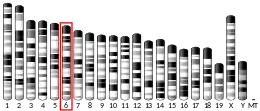| MGP | |||||||||||||||||||||||||||||||||||||||||||||||||||
|---|---|---|---|---|---|---|---|---|---|---|---|---|---|---|---|---|---|---|---|---|---|---|---|---|---|---|---|---|---|---|---|---|---|---|---|---|---|---|---|---|---|---|---|---|---|---|---|---|---|---|---|
| Identifiers | |||||||||||||||||||||||||||||||||||||||||||||||||||
| Aliases | MGP, MGLAP, NTI, GIG36, matrix Gla protein | ||||||||||||||||||||||||||||||||||||||||||||||||||
| External IDs | OMIM: 154870 MGI: 96976 HomoloGene: 693 GeneCards: MGP | ||||||||||||||||||||||||||||||||||||||||||||||||||
| |||||||||||||||||||||||||||||||||||||||||||||||||||
| |||||||||||||||||||||||||||||||||||||||||||||||||||
| |||||||||||||||||||||||||||||||||||||||||||||||||||
| |||||||||||||||||||||||||||||||||||||||||||||||||||
| |||||||||||||||||||||||||||||||||||||||||||||||||||
| Wikidata | |||||||||||||||||||||||||||||||||||||||||||||||||||
| |||||||||||||||||||||||||||||||||||||||||||||||||||
Matrix Gla protein (MGP) is member of a family of vitamin K2 dependent, Gla-containing proteins. MGP has a high affinity binding to calcium ions, similar to other Gla-containing proteins. The protein acts as an inhibitor of vascular mineralization and plays a role in bone organization.[5][6]
MGP is found in a number of body tissues in mammals, birds, and fish. Its mRNA is present in bone, cartilage, heart, and kidney.[7]
It is present in bone together with the related vitamin K2-dependent protein osteocalcin. In bone, its production is increased by vitamin D.
Genetics
The MGP was linked to the short arm of chromosome 12 in 1990.[8] Its mRNA sequence length is 585 bases long in humans.[9]
Physiology
MGP and osteocalcin are both calcium-binding proteins that may participate in the organisation of bone tissue. Both have glutamate residues that are post-translationally carboxylated by the enzyme gamma-glutamyl carboxylase in a reaction that requires Vitamin K hydroquinone.
Role in disease
Abnormalities in the MGP gene have been linked with Keutel syndrome, a rare condition characterised by abnormal calcium deposition in cartilage, peripheral stenosis of the pulmonary artery, and midfacial hypoplasia.[10]
Mice that lack MGP develop to term but die within two months as a result of arterial calcification which leads to blood-vessel rupture.[6]
References
- 1 2 3 GRCh38: Ensembl release 89: ENSG00000111341 - Ensembl, May 2017
- 1 2 3 GRCm38: Ensembl release 89: ENSMUSG00000030218 - Ensembl, May 2017
- ↑ "Human PubMed Reference:". National Center for Biotechnology Information, U.S. National Library of Medicine.
- ↑ "Mouse PubMed Reference:". National Center for Biotechnology Information, U.S. National Library of Medicine.
- ↑ Yao Y, Jumabay M, Ly A, Radparvar M, Cubberly MR, Boström KI (2013). "A role for the endothelium in vascular calcification". Circ. Res. 113 (5): 495–504. doi:10.1161/CIRCRESAHA.113.301792. PMC 3851028. PMID 23852538.
- 1 2 Luo G, Ducy P, McKee MD, Pinero GJ, Loyer E, Behringer RR, Karsenty G (March 1997). "Spontaneous calcification of arteries and cartilage in mice lacking matrix GLA protein". Nature. 386 (6620): 78–81. Bibcode:1997Natur.386...78L. doi:10.1038/386078a0. PMID 9052783. S2CID 4335985.
- ↑ Pinto JP, Conceição N, Gavaia PJ, Cancela ML (2003). "Matrix Gla protein gene expression and protein accumulation colocalize with cartilage distribution during development of the teleost fish Sparus aurata". Bone. 32 (3): 201–10. doi:10.1016/S8756-3282(02)00981-X. PMID 12667547.
- ↑ Cancela L, Hsieh CL, Francke U, Price PA (1990). "Molecular structure, chromosome assignment, and promoter organization of the human matrix Gla protein gene". J. Biol. Chem. 265 (25): 15040–8. doi:10.1016/S0021-9258(18)77221-9. PMID 2394711.
- ↑ "Sequence: M58549.1 : Human matrix Gla protein (MGP) mRNA, complete cds". European Nucleotide Archive. European Bioinformatics Institute.
- ↑ Munroe PB, Olgunturk RO, Fryns JP, Van Maldergem L, Ziereisen F, Yuksel B, Gardiner RM, Chung E (1999). "Mutations in the gene encoding the human matrix Gla protein cause Keutel syndrome". Nat. Genet. 21 (1): 142–4. doi:10.1038/5102. PMID 9916809. S2CID 1244954.
External links
- matrix+Gla+protein at the U.S. National Library of Medicine Medical Subject Headings (MeSH)



